
The North Caucasian Languages
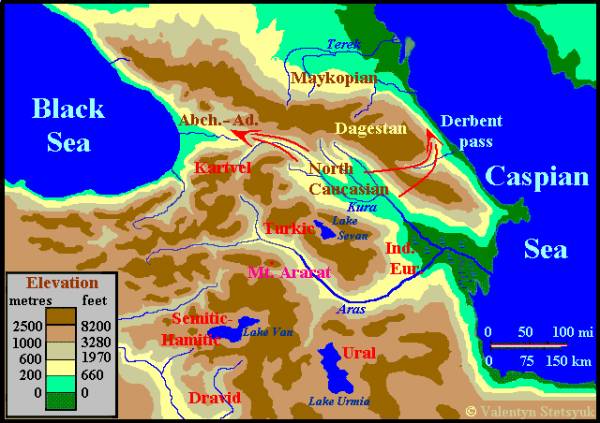
The intense colonization of the Caucasus took place in Acheulean times, although archaeological finds of earlier time are known too. By the end of Acheulean period people have already invaded the territory of modern Armenia, Georgia, Azerbaijan and North Caucasus. Obviously, this large region has since been inhabited continuously, but a man of modern type with the dominant settlement direction from the south northward appeared hear not earlier than the speakers of the Nostratic languages populated the area of three lakes around the Mount Ararat.
Left: The ethnic map of the Caucasus at Neolith time
Many linguists join the Abkhazo-Adyghe and the Nakh-Dagestan Languages into a North Caucasian family, sometimes simply called Caucasian. The South Caucasian languages (we call them Kartvelian) belong to one super-family (phylum) which is named the Nostratic languages.
Many linguists join the Abkhaz-Adyghe and the Nakh-Dagestan Languages into a North Caucasian family, sometimes simply called Caucasian. The South Caucasian languages (we call them Kartvelian) belong to one super-family (phylum) which is named the Nostratic languages. The relation of the Abkhaz-Adyghe and Nakh-Dagestani languages to any language family has not yet been determined. As their speakers lived in the Caucasus in close proximity to the Kartvelian languages group from ancient times, we may assume that these languages can also be Nostratic. Lexical data on North Caucasian languages have been collected in the tables by the group of scientists led by Nikolai Starostin the project The Tower of Babel. Data taken from the tables were used for the study of these languages by graphic-alytical method, but an attempt to build a common model of relationship for them failed.
However, models for Abkhaz-Adyghe and Nakh-Dagestani languages have been built successfully. They will be considered below. Probably both languages were derived from a common ancestor split into two dialects at an early stage of development. When the speaker of these dialects migrated to different places, their tongues were split once again. The common Urheimat of the ancestors of Abkhaz-Adyghe and Nakh-Dagestanian peoples had to be located somewhere not far and between their settlements at present that is on the Caucasus. There was in the Kura Valley in modern-day Azerbaijan only one free area not settled by some Nostratic people.

Left: The map of the location of the common Urheimat of the ancestors of Abkhazo-Adyghean and Nakh-Dagestanian peoples.
In this case, the language of the local population could belong to Nostratic super-family. Earlier of all Nostratic tribes, the speakers of this language separated out of Nostratic community and migrated to the new places of their settlement in Dagestan and Abkhazia. Here their languages were parted in separated dialects which in course of time developed to new languages. Some part of Dagestanian population settled on the wide lowlands of the Northern Caucasus. Later they have developed so called Maykop culture which existed in the Fore Caucasus till the end of 3th mill. BC. This population will be termed by us farther Maykopians.
The Abkhazo-Adyghean languages
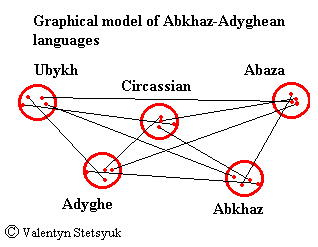
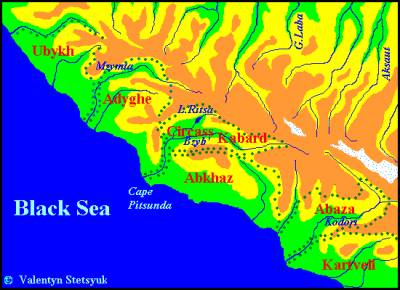
At present the Abkhaz-Adyghe languages also called Northwest Caucasian languages are presented by the Abkhaz, Abaza, Adyghe, Kabardian/Circassian, and Ubykh languages. The graphical model of their relationship is very easy to construct (see left). Presumably place for the model on the map should look somewhere near the modern-day settlements of Abkhaz-Adyghe people. A small number of languages of this group does not allow to say confidently that the chosen place may be true. Supposing that the speakers of Abkhaz-Adyghe languages settled the territory of their ancestors, the place for the chart was found on the Northwest Caucasus (see right). Boundaries between the single areal of the Abkhaz-Adyghe languages are partially mountain ranges and rivers in the lower part of the Black Sea coast.
The Dagestanian and Nakh languages

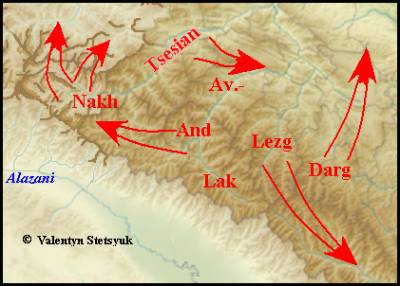
The Nakh-Dagestanian language family consist of the Dargwa and Lakish languages and such language groups: Nakh, Avar-Andi, Didoic), Tsezian, Lezghian. Obviously, at first six languages were arisen in Dagestan that is each mentioned groups has its parent language which we will name Nakh, Avar-Andi, Tsezian) Lezghian. The graphic model of the Nakh-Dagestanian language constructed by means of Tower of Babel is shown (see left). The model is good located in the valleys of Dagestan mountain country. Boundaries between the areas are mountain ranges (sse the map right)
Subsequentlythe speaker of Nakh-Dagestani languages resettled along the Greater Caucasus Mountain Range (resettlement directions are shown on the map by arrows), and in new places settlements, some languages dismembered again. For them were constructed graphical models

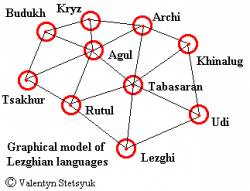

The graphical models of the Lezghian, Tsezian, and Andian (Avaroandian) languages.
The three last models can be located in mountain country of Dagestan and next areas of the Eastern Cacasus (see map).
A dense network of mountain ranges of Dagestan, although created quite a number of isolated ethno-generating areas, nevertheless let population to migrate through the available passes. It is clear that need for migration arisen because of the growth of the population.
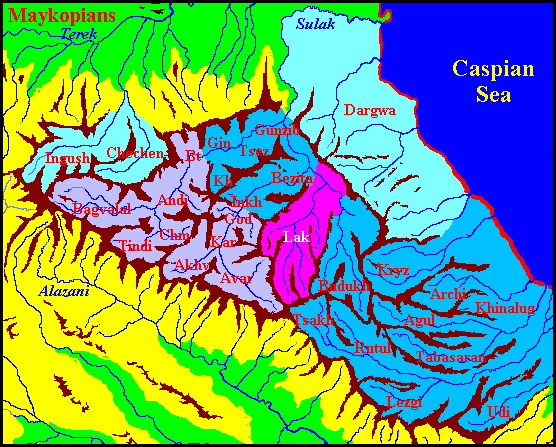
Languages developed out of the former Nakh language
The Proto-Nakh language gave origin of present-day Chechen, Ingush, Batsbi, and Kisti languages. It was formed in a large habitat, limited by the main Caucasian, Bogos and Snowy ridges. Now this area is partly within the territory of Georgia, the modern border with Russia separates area into two parts.
Western part of the area form valleys of Piriketeli Alazani and Tusheti Alazan Rivers merging in the Andean Koisu River. Eastern part of the area is located in the valley of its tributary Metlyuda River. Obviously, the ancestors of the Chechens and Ingush left their ancestral home under pressure Avar-Andean tribes who came through Tsuntin Pass (2464 m above sea level) from the Avar Koisu Valley. Going through the mountain pass between Big Borbalo on the Main Caucasian ridge and ridge Nukatl, Nakh tribes came to the upper reaches of the Argun River and went with its steam to merge with the Sharoargun River populating valleys of both rivers. Just on these valleys, finally the Chechen and Ingush languages were finally formed. Batsbi and Kisti languages developed on the western part of the area under the influence of Georgian.
Languages developed out of the former Avar-Andi parent language..
The Bagvala language was formed in the western part of the area of the Proto-Nakh language, that is on the territory which now belongs to Georgia. At present native speakers of Bagvala (Bagulaly otherwise) form no majority in any of the regions of Dagestan and are dwelling in the countryside, which is just adjacent to their historic homeland in Tsumandin district of Dagestan. Obviously, the bulk of them was assimilated by Georgians or Batsbi and Kisti people.
The Chamvala language was formed in the area on both banks of the river Avar Koysu limited on the north by Snowy range with the main peak Diklosmta, on the east by the Mountain Addala-Shuhgelmeer. Just there is Tsumadin region of Dagestan, where the bulk of the nation Chamala is concentrated which has relative majority (40%) here.
The native speakers of Tindi (Tyndali) inhabit the same Tsumadin district, accounting for 15% of the population. It is north of their ancestral home, which was located in Tsuntin district where the absolute majority are native speakers of the languages belonging to the group of Tsezi (Didoian, Bezhita, Gunzib, Ginukh). here.
The Urheimat of Akhvakh was localized on the territory of the Bezhita land of Dagestan with a minor amount of the population (less than 10 thousand). Except Bezhita, Gunzib and Didoian people inhabit it. On the contrary, Akhvakh people, also in small quantities (seven thousand) inhabit Akhvakh district where relative majority is conctituted by Karatin people whose language was formed just in this area. Since Akhvakh also live in one of the villages in Azerbaijan, we can assume that they left their ancestral home, migrating as northward and southward.
The areas of forming of the Botlikh and Andian languages are defined in general correctly. Currently the speakers of these languages inhabit Botlikh district, which partly correspond to the area of the Botlikh language, while the area of the Andian language has been located to the south and sharp boundaries between them is absent.
The area of formation of the Avar language has been located in Tliaratyn district of Dagestan, it is just here where the Avars constitute the vast majority of the population (99, 07%).
Languages developed out of the former Didoian (Tsezi) parent language.
The Avars are these which are supposed to be absolute majority of Shamil, Charodin, Gunib Khunzakh, Gergebil, Untsukul, Gumbet, and Kizilyurt districts, so the accuracy of localizing the areas of formation Didoian languages group can not be verified. Most of the speakers of these languages in a small number dwell well south of the territory, which was defined as their ancestral home. However, there are near the old settlement sites in Khasavyurt, Kizilyurt, Kizlyar districts some villages inhabited by people speaking the Tsezi, Khvarshi, anf Inkhokvari languages. We can assume that at some time a part of Didoian, Bezhita, Gunzib, Ginukh and migrated southward because of the inroads of newcomers, while Khvashi, Inkhokvari people stayed on their places. Moving up the valley of the Andian Koysu River, the migrants could not find a place for themselves among the Avar-Andi population, until they came to the upper reaches of the Metluda River and settled on the territory that is now the part of Tsuntin and Tsumadin districts and Bezhita land of Dagestan. Here they live scattered in separate groups mixed with each other and Avars, preserving native languages. Strangers who forced to the migration of Didioan, Bezhita, Gunzib, Gihukh people were Kipchak tribes, whose descendants are the modern-day Kumyks inhabited to north and north-east of the speakers of the Dagestan languages. This hypothesis is confirmed by local place names, in particular by the names of rivers, having in its names an element Koysu of clearly Turkic origin (quj,qoj "to pour, flow" and su "water"). Over time reverse movement of the population could begin, because Turkic population neither in the basins of the Andian and Avar Koysu, Karakoysu Rivers is absent.
The Lakish and Dargin languages.
Pressed by Avar-Andi tribe, the speakers of the Lakish language left their ancestral home on the upper reaches of the Dzhurmuta river and moved to the valley of the Karakoysu River its tributaries. Here they live in Lak and Kulin districts of Dagestan, keeping your common language. THe ancestors of Dargin (Dargwa) inhabited the area on the lower reaches of the rivers flowing to the Caspian Sea. There are no special geographical obstacles, so their language avoided division process. Dargwapeople settled over a wide area until the Kuma River. Already mentioned Kipchaks, have came in Fore Caucasus, moved to Caspian Sea south of the mouth of the Terek River and occupied a steppe part of Dargin territory adjacent to foothills and along the sea. This assumption is confirmed by he modern-day settlements of Kumyks.
The languages developed out of the former Lezghian parent language.
Forced out of the valley of the Karakoysu River by Lakish people, the ancestors of the speakers of Lezghian languages moved into the upper reaches of the Samur and Khunnikh River. Present-day settlements the peoples of this group meet their languages kinship model only partially. In accordance with the scheme, Rutuls and Tsakhurs live in Rutul District of Dagestan, Lezghians inhabit Akhtin, Magaramkent, and Kurakh districts, Aguls – in Agul, Tabasarans – in Khiv districts. Residence of minorities do not correspond to the scheme absolutely. So Archi people together with the Avars live in Charodin district of Dagestan, people Budukh and Kryz occupy several villages in Azerbaijan and Udi people live in different places in Azerbaijan, Georgia, Dagestan, and even Kazakhstan.
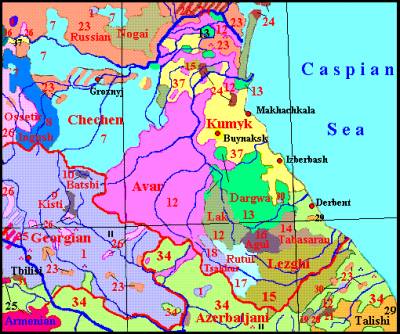
Left: Ethno-Linguistic map of Dagestan at the middle of the 20 cen.
The Kartvelian languages 1. Georgian
The Nakh languages 7. Chechen 8. Ingush 9. Kisti 10. batsbi
The Dagestan languages 11. Avar 12. Lakish 13. Dargwa 14. Tabasaran 15. Lesgi 16. Aguli 17. Rytul 18. Tsakhur 19. Khinalugi 20. Kriz 21. Budukh 22. Udi
The Turkic languages 34. Azerbaijan 35. Karachay 36. Balkar 37. Kumyk 38. Nogai 39. Turkmen 40. Tatar 41. Kazakh
The Indo-European languages 23. Russian 24. Ukrainian 25. Armenian 26. Ossetic 27. Kurdish 28. Talishi 29. Tatish 30. Jewish-Tatish 31. Greek 32. German 33. Romanian
The Dagestan languages 11. Avar 12. Lakish 13. Dargwa 14. Tabasaran 15. Lesgi 16. Aguli 17. Rytul 18. Tsakhur 19. Khinalugi 20. Kriz 21. Budukh 22. Udi
The Turkic languages 34. Azerbaijan 35. Karachay 36. Balkar 37. Kumyk 38. Nogai 39. Turkmen 40. Tatar 41. Kazakh
The Indo-European languages 23. Russian 24. Ukrainian 25. Armenian 26. Ossetic 27. Kurdish 28. Talishi 29. Tatish 30. Jewish-Tatish 31. Greek 32. German 33. Romanian
Comparison of the maps of areas where the Nakh-Dagestani languages were arisen from a common parent language with present-day settlement places of their respective speakers showed that they really were formed on the territory of Dagestan, and we see that the related Abkhaz-Circassian and Nakh-Dagestani languages were undergoing division process on quite a distance from each other, that is they were dwelling on these areas during long historical time. Obviously, as we suggested, in antiquity two groups of a common North Caucasian language speakers migrated from common Urheimat in two different directions, namely, the ancestors of Abkhaz-Adyghes moved to the Black Sea and settled north of Kartvels but the ancestors of Nakh and Dagestan people settled in the hill country of Dagestan.

Right: The map of the population of the Caucasus at Scythian time
The studies suggest that up to the present day the ancient population of the Caucasus, with the exception of Maikopians, remained at their places of residence or in their vicinity. There an ancient Kartvelian language was divided into separate dialects, of which the Georgian, Megrel (Mingrelian), Lazian and Svan languages evolved later. However, from time to time the new settlers arrived to the Caucasus. At the turn of the 3rd and 2nd millennium BC the North Caucasus was settled by Turkic tribes (ancestors of the Turks, Kumyks, Karachay, Balkar, Turkmen, and Gagauz). Armenians and Iranian tribe of the Medes, which were joined later by other Iranians: Talyshis, Gilyanis, Baluchis, Mazanderani peoples came to the South Caucasus. Known history of Albanians and the Caspian Sea, occupying Transcaucasia in Scythian time, obviously belonged to that part of the North Caucasus carriers hypothetical language, which remained at their historical ancestral home. Mentioned in historical documents Colchis were the ancestors of modern Megrelians and Lazians.
The Relationship of the Sino-Tibetan languages
The Relationship of the Altaic and Turkic languages.
The Anthropological Type of the Autochthon Europeans
The Urheimat of the Nostratic Languages











